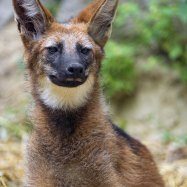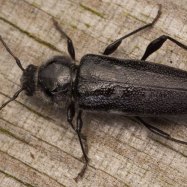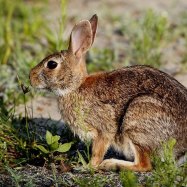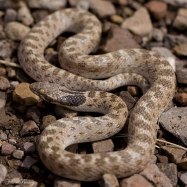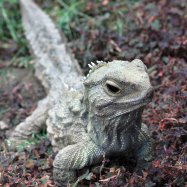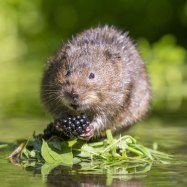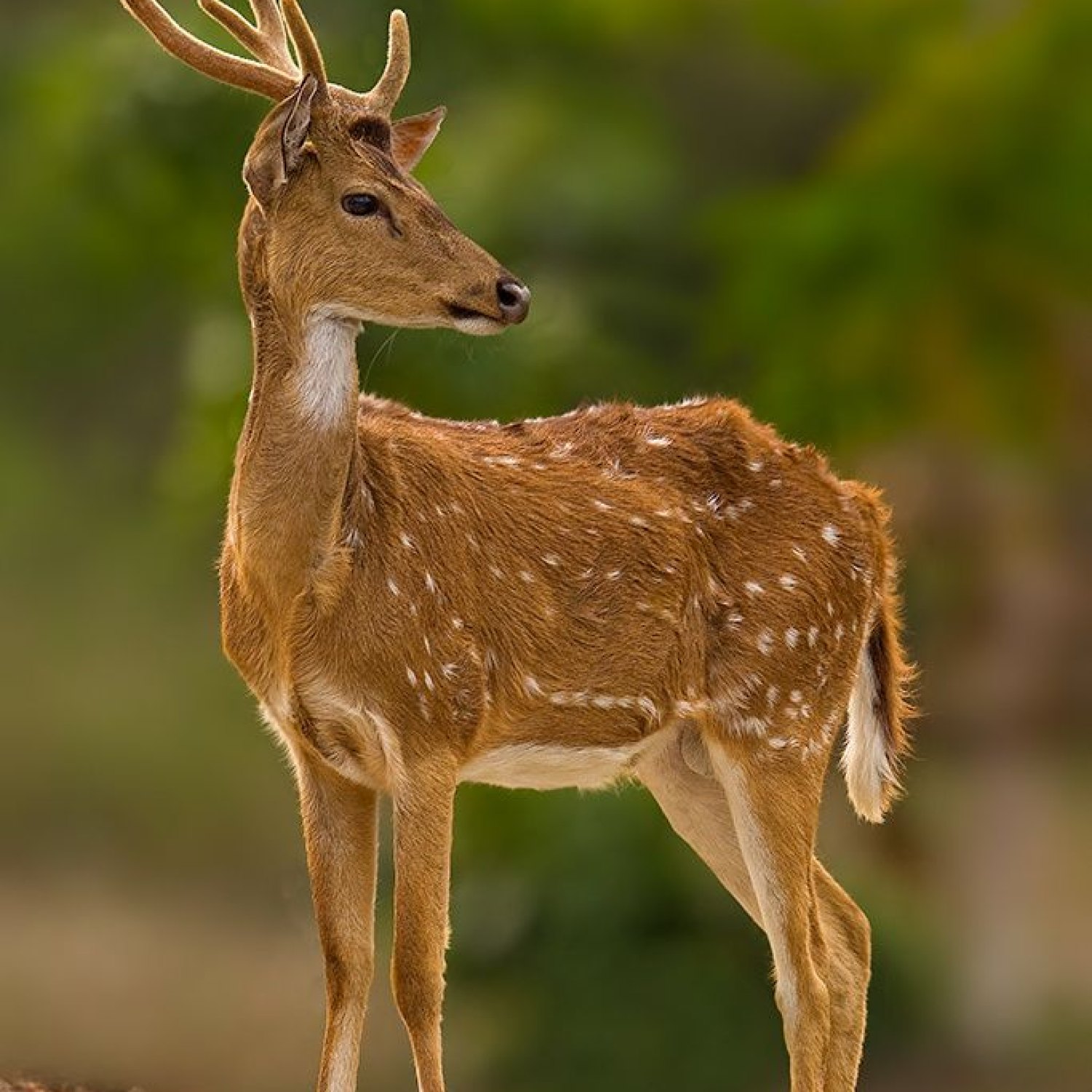
Sambar
180-270 cm
The Sambar is a majestic animal found in Asia. With its distinct large and robust body, it can grow up to 180-270 cm long. Belonging to the Cervidae family, the Sambar can be spotted in various countries in Asia. This herbivorous animal feeds on a diverse diet of leaves, grass, and fruits. Its impressive size and graceful demeanor make the Sambar a fascinating creature to observe in the wild. #Sambar #Wildlife #Asia #Nature
Animal Details Summary:
Common Name: Sambar
Kingdom: Animalia
Habitat: Forest, grasslands, and wetlands
The Majestic Sambar: A Graceful Giant of South and Southeast Asia
Amidst the dense forests of South and Southeast Asia lives a magnificent creature that has captured the hearts of nature-lovers and wildlife enthusiasts. The Sambar, also known by its scientific name Rusa unicolor, is a large and robust deer species that thrives in a variety of habitats, from lush forests to vast grasslands and even wetlands. Its immense size, graceful movements, and striking coloration have made it a popular subject for artists, photographers, and filmmakers, but there is much more to this animal than meets the eye.A Royal Entrance
The Sambar's scientific name, Rusa unicolor, translates to "one-colored deer," which is a perfect description of its appearance Sambar. These majestic creatures are known for their reddish-brown to dark brown coloration, with a sleek, shiny coat that shines under the sun. Their bodies are also adorned with white markings on their throat and around their eyes, giving them a regal appearance.Their large, curved antlers are another distinguishing feature that makes them stand out amongst other deer species. The antlers are typically found only on males and can grow up to a whopping 45 inches in length, making them an impressive sight to behold.
A Habitat of Diversity
Sambar deer are adaptable creatures that can survive in a range of habitats. They are commonly found in forests, both tropical and temperate, as well as grasslands and wetlands. Their preference for dense vegetation allows them to blend seamlessly into their surroundings, making them difficult to spot.In countries like India, where they are considered the national animal, Sambar can be found in almost every state, from the thick jungles of Madhya Pradesh to the wetlands of Assam. However, they are also found in other parts of South and Southeast Asia, including Sri Lanka, Nepal, Myanmar, and Thailand Saarloos Wolfdog. Their wide distribution is a testament to their resilience and ability to thrive in different climatic conditions.
Feast for Herbivores
Sambar deer are entirely herbivorous, and their diet mainly consists of grass, leaves, fruits, and even aquatic plants. Due to their browsing behavior, they are considered to be major contributors to seed dispersal in the forests they inhabit. This makes them vital for maintaining a healthy ecosystem.Their ability to feed on a wide variety of plants also makes them essential for the preservation of many plant species. In some cases, Sambar deer have been known to consume plants that are toxic to other herbivores, thus preventing an overgrowth of these plants and creating a balance in the ecosystem.
A Crown Jewel of Asia
The Sambar's geographical distribution spans across South and Southeast Asia, making it a valuable asset to this region's biodiversity. Their presence in forests helps in pollination and seed dispersal, thus contributing to the ecosystem's health. Moreover, they are an essential prey species for several apex predators, including tigers, leopards, and crocodiles.However, their population has been declining over the years due to loss of habitat, hunting, and poaching. In some places, they are also considered a nuisance to agricultural practices, leading to conflicts with humans. Therefore, conservation efforts are crucial for the species' survival, especially in regions where their numbers are dwindling.
The Science Behind the Sambar
Sambar belong to the Animalia kingdom, meaning they are multicellular, eukaryotic organisms. As members of the Phylum Chordata, they possess a notochord, a hollow nerve cord, pharyngeal slits, and a post-anal tail during some stage of their life cycle. These characteristics are essential for proper nerve and muscle functioning, making them an efficient and agile species.As part of the Mammalia class, Sambar deer are warm-blooded, vertebrate animals that give birth to live young and possess mammary glands to produce milk for their offspring. They also have hair or fur covering their bodies and are capable of regulating their body temperature, allowing them to survive in varying climatic conditions.
Their order, Artiodactyla, translates to "even-toed," referring to their cloven hooves, which are split into two. This adaptation helps Sambar deer to navigate through rough and uneven terrain easily. In contrast, their family, Cervidae, comprises deer and elk species, which they share a close evolutionary relationship with.
The Mystical Sambar in Folklore and Spirituality
The Sambar's majestic presence and mystical appearance have captivated the imaginations of people, leading to their representation in various folk stories, myths, and even spiritual beliefs. In India, the Sambar is considered a sacred animal and is associated with the god of wealth, Kubera. In some parts of the country, they are also considered messengers of the gods and are believed to bring good luck and prosperity.In Nepal, Sambar deer are revered as a symbol of good health and are often depicted in traditional paintings and sculptures. They are also an essential part of the Tharu community's culture, where they hold traditional beliefs and rituals centered around this magnificent animal.
Their graceful movements and striking coloration have also been portrayed in ancient cave paintings, showcasing the animal's significance throughout history.
The Sambar: A Species Worth Protecting
The Sambar is a beautiful and resilient creature that has captured the hearts of people for centuries. Its significance in terms of environmental conservation and cultural beliefs makes it a unique and valuable species that must be preserved for future generations to appreciate.Conservation efforts, such as protecting their habitat and regulating hunting and poaching, are vital for the long-term survival of this species. With proper management and a collective effort from humans, we can ensure that the Sambar continues to roam the forests of Asia, enchanting us with its majestic presence for years to come.

Sambar
Animal Details Sambar - Scientific Name: Rusa unicolor
- Category: Animals S
- Scientific Name: Rusa unicolor
- Common Name: Sambar
- Kingdom: Animalia
- Phylum: Chordata
- Class: Mammalia
- Order: Artiodactyla
- Family: Cervidae
- Habitat: Forest, grasslands, and wetlands
- Feeding Method: Herbivorous
- Geographical Distribution: South and Southeast Asia
- Country of Origin: India
- Location: Various countries in Asia
- Animal Coloration: Reddish-brown to dark brown
- Body Shape: Large and robust
- Length: 180-270 cm
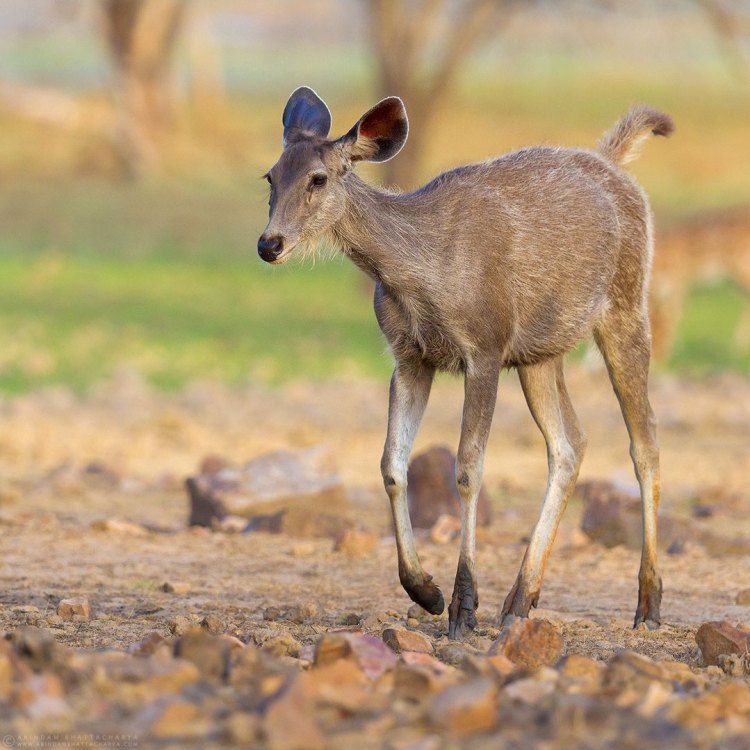
Sambar
- Adult Size: Height at shoulder: 120-160 cm, Weight: 200-300 kg
- Average Lifespan: 10-20 years
- Reproduction: Sexual
- Reproductive Behavior: Mating occurs throughout the year
- Sound or Call: Bark-like alarm calls
- Migration Pattern: Non-migratory, but may exhibit seasonal movements
- Social Groups: Solitary or small groups
- Behavior: Mostly active at dusk and dawn
- Threats: Habitat loss, hunting, and poaching
- Conservation Status: Vulnerable
- Impact on Ecosystem: Important herbivores, help maintain forest and grassland ecosystems
- Human Use: Hunted for meat and antlers, also kept in captivity in some places
- Distinctive Features: Large size, long and curved antlers
- Interesting Facts: Second-largest deer species in the world after the moose
- Predator: Humans, tigers, leopards
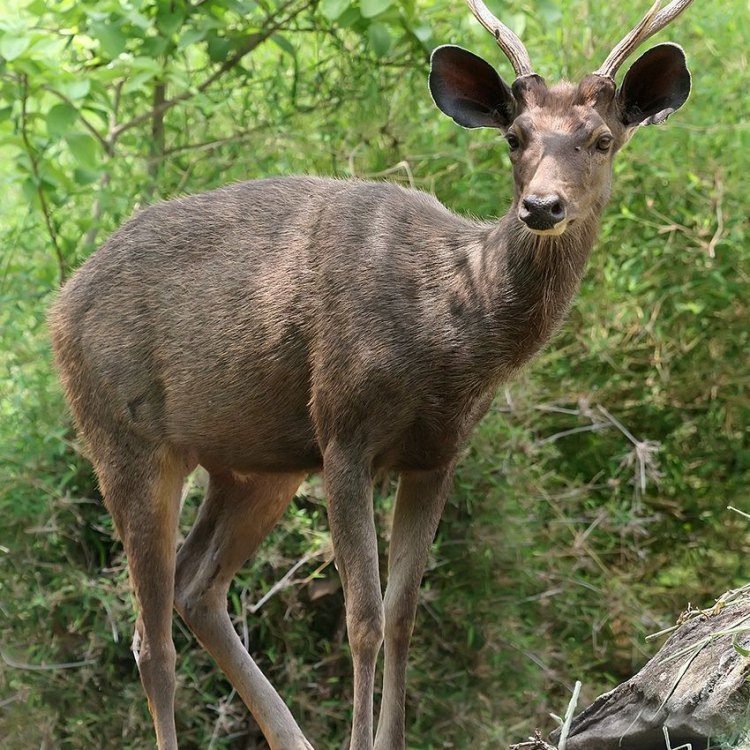
Rusa unicolor
The Majestic Sambar: An Iconic Herbivore
The sun was setting over the lush green forests, casting a golden glow on the trees and bushes. As the twilight settled in, the forest came alive with the calls and rustling of animals. Among them, a majestic creature stood out - the Sambar.The Sambar (Rusa unicolor) is a large deer species, native to the Indian subcontinent and Southeast Asia PeaceOfAnimals.Com. It is the second-largest deer species in the world, after the moose, and is known for its impressive size and distinctive features.
Adult Sambar can reach a height of 120-160 cm at the shoulder and weigh between 200-300 kg. They are generally solitary or found in small groups, preferring to live in dense forests, grasslands, and wetlands.
Reproduction and Behavior
When it comes to reproduction, the Sambar follows the traditional sexual route. They have a lifespan of 10-20 years and mating can occur throughout the year. During this time, the male Sambar will emit a strong musk scent to attract females. Mating is preceded by a ritualized behavior, where the male displays his dominance through vocalizations and antler displays.
Although mostly active during dawn and dusk, the Sambar can also be spotted during the day, especially near water sources. They are excellent swimmers and are often found wading through shallow water to feed on aquatic plants Scimitar Horned Oryx. However, they are not migratory animals and usually stay within their home range, which can be up to 30 square kilometers.
Sounds and Calls
If you happen to be walking through a forest where Sambar resides, you may hear a bark-like alarm call, which is the most common vocalization of this species. This call is used to warn other individuals of potential danger and can be heard up to 1 kilometer away. Additionally, they may also make growls, grunts, and snorts to communicate with each other.
Distinctive Features
One cannot talk about the Sambar without mentioning its most distinctive feature - their large and curved antlers. These antlers can reach a size of up to 110 cm and have three tines, making them a prized possession by hunters. They are also unique in the way they shed their antlers. Unlike other deer species, the Sambar sheds its antlers by breaking them at the base rather than losing them whole.
The color of the Sambar's coat is another unique aspect. Depending on their habitat, Sambar can range from reddish-brown to grayish-brown. They also have a light-colored patch on their throat, which is often called the bib.
Threats and Conservation Status
Despite being a formidable creature, the Sambar faces multiple threats to its survival. Habitat loss due to deforestation, hunting for meat and antlers, and illegal poaching for its body parts are some of the major factors contributing to its decline in numbers. As a result, the Sambar is currently classified as vulnerable on the International Union for Conservation of Nature (IUCN) Red List.
Impact on Ecosystem
Apart from being a magnificent species, the Sambar also plays a crucial role in its ecosystem as an important herbivore. They feed on a variety of plants, including leaves, fruits, and grasses, and thus, help in maintaining the balance of forest and grassland ecosystems. Their droppings also act as a source of nutrients for other animals, and their grazing behavior helps in controlling the growth of vegetation.
Human Use
Unfortunately, the Sambar has also been hunted for its meat and antlers, which are considered a delicacy in some parts of Southeast Asia. It is also kept in captivity in some places for recreational purposes and for farming its antlers, which are used in traditional medicine.
Predators
Like most animals, the Sambar also has predators that pose a threat to their survival. Humans, with their hunting and poaching activities, are one of the biggest threats to the Sambar. In addition, they are also hunted by tigers and leopards, who see them as a source of food.
Interesting Facts
Apart from being the second-largest deer species in the world, there are many other interesting facts about the Sambar. Did you know that the name "Sambar" comes from the Tamil word "Chambari," which means "horned animal"? Also, the Sambar's antlers are used in traditional Asian medicine, believed to have medicinal properties for treating various ailments. However, there is no scientific evidence to support these claims.
The Importance of Conservation
The Sambar's decline in numbers is a clear indication of the dire need for conservation efforts. With ongoing habitat loss and poaching activities, it is crucial to protect and preserve this iconic species. Governments and conservation organizations are taking various steps, such as implementing stricter laws and creating protected areas, to ensure the survival of the Sambar.
It is also essential for individuals to be aware of the impact of their actions on the environment and take steps to reduce their negative impact. By conserving the Sambar, we not only protect a magnificent species, but also help maintain the balance of delicate ecosystems.
A Final Note
In conclusion, the Sambar is much more than just a large deer species. It is an iconic herbivore that plays a crucial role in maintaining the balance of its ecosystem. Its distinctive features, reproductive behavior, and vocalizations make it a fascinating creature to study. However, it is essential to remember that the Sambar is also a vulnerable species facing various threats, and it is our responsibility to ensure its survival for future generations to witness its majestic presence in our forests.
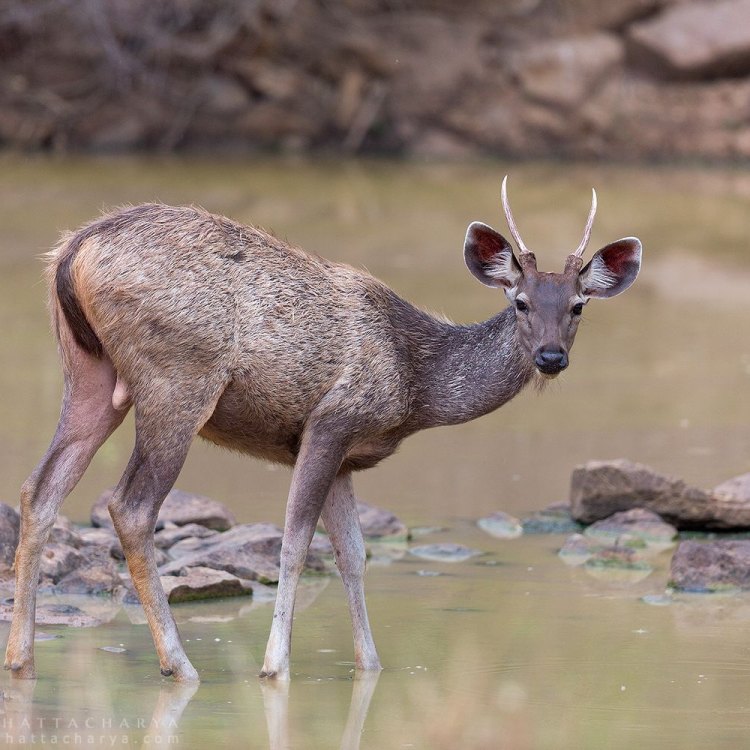
The Majestic Sambar: A Graceful Giant of South and Southeast Asia
Disclaimer: The content provided is for informational purposes only. We cannot guarantee the accuracy of the information on this page 100%. All information provided here may change without prior notice.


